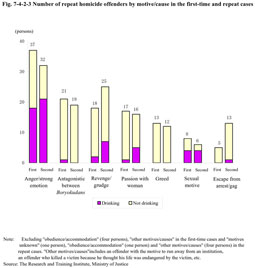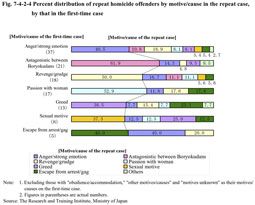| Previous Next Index Image Index Year Selection | |
|
|
2 Motives or causes
Fig. 7-4-2-3 shows the number of repeat homicide offenders by motive or cause, as well as the number of those who were taking alcohol before the offense, in the first-time cases and repeat cases, respectively.
Fig. 7-4-2-3 Number of repeat homicide offenders by motive/cause in the first-time and repeat cases The number of cases where the motive or cause was ‘anger/strong emotion’ was the largest both with first-time cases and repeat cases. Taking a look at the percent ratio of offenders who were taking alcohol before the offense, the ratio was the highest for “sexual motive”, with 50.0% for first-time cases and 66.7% for repeat cases. “Anger/strong emotion” followed with 48.6% for first-time cases and 65.6% for repeat cases. In these cases, there were no cases where intoxication with alcohol seemed to have directly led to the offense, but in many cases, influence of alcohol seemed to have had indirect effects on the criminal acts by loosening the offender's self-control or emboldening him. Furthermore, where “power struggle between Boryokudans” or “greed” was the motive or cause for crime, few offenders were taking alcohol before the criminal acts.Next, Fig. 7-4-2-4 shows the percent distribution of repeat homicide offenders by motive or cause in the repeat case, by that in the first-time case. Fig. 7-4-2-4 Percent distribution of repeat homicide offenders by motive/cause in the repeat case, by that in the first-time case According to the figure, it is first noted that the ratio of offenders who committed the repeat case with the same motive or cause as in the first-time case (hereinafter referred to as the “same motive rate” in this chapter) is higher with all of the motive/cause categories. Especially with cases where the motive or cause in the first-time case was “power struggle between Boryokudans”, the same motive rate was extremely high (61.9%), followed by “infatuation” (52.9%), “Reprisal/grudge” (50.0%), “Anger/strong emotion” (40.5%), “clearance escape/gag” (40.0%), “greed” (38.5%) and “sexual motive” (37.5%). It has been revealed, in regard to repeat homicide offenders, a considerable number of them committed homicide with the same motive/cause in first-time and repeat cases.Note that, as far as homicide cases are concerned, their motive/cause is not single in most cases, so in this research, we made analyses by selecting three main criminal motives/causes in first-time and repeat cases. As a criminal motive/cause that constituted part of the whole criminal motives/causes for either one or both of first-time and repeat cases, “anger/strong emotion” constituted the highest proportion at 74.2%, followed by “reprisal/grudge” (48.8%), “greed” (26.6%), “power struggle between Boryokudans” (25.0%), “infatuation” (21.9%), “intoxication with alcohol” (21.9%), “clearance escape/gag” (18.0%) and “sexual motive” (10.9%) in that order. |

